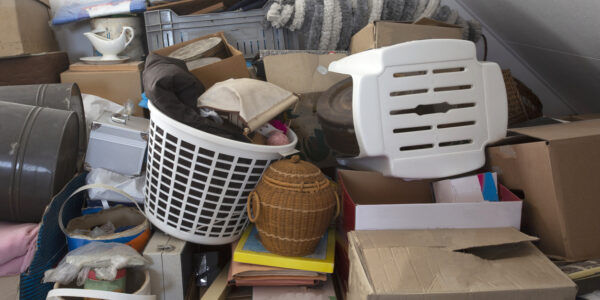When It’s More Than “Stuff”

We all acquire items throughout our lives. Some items are utilitarian (e.g., wooden kitchen spoons). Some are decorative (e.g., a beautiful watercolor painting). Some items are wanted (e.g., the magazine you subscribe to). Some are unwelcome (e.g., the seemingly unstoppable junk mail).
Some items connect us to the past and others carry an emotional connection to people or places we love but no longer see. In fact, collecting and saving objects occurs in all cultures on earth—even nomadic groups carry items that are meaningful within their culture.
So how much is “too much” stuff? And, what about that emotional connection, anyway? How do I know if it’s a healthy reminder of a loved one who has passed, or something else?
In 2013, hoarding became a mental health diagnosis. Prior to that time, hoarding had been categorized as obsessive-compulsive disorder (OCD). But research studies showed that hoarding is more common than OCD; many people who hoard do not meet the criteria for other types of OCD; and treatments for OCD are not always effective for hoarding.
So then, what is hoarding disorder? Some symptoms include:
- Difficulty throwing out or getting rid of things, regardless of their actual value.
- Feeling a need to save items, and the thought of getting rid of them is upsetting.
- Cluttering to the point where you cannot use room(s) or, in some cases, a bathtub, shower, or bed.
Some things you might see if you visit a person with a hoarding disorder:
- Piles or stacks of items (e.g., newspapers, clothes, paperwork, books).
- Buildup of food or trash, leading to unsanitary conditions.
- A person in distress, experiencing problems keeping their environment clean and safe (and this applies to pets in the home, too).
Why don’t they just throw it all away and start over? That seems like the easiest solution.
While starting over may seem like the easiest solution, doing a “clean out” (or, less respectfully, a “dig out”) is not usually a good choice for the long-term solution. The reason is simple: clean outs don’t work.
Research has shown that, after cleaning out the homes of people who hoard, the clutter comes back. And it tends to return faster and more intensive than before. Why would this be? The theory is that the person who hoards is exhibiting a trauma response.
The person who hoards has a mental health condition that needs addressing. In a trauma response, the mind works very hard to protect itself from further distress. If collecting newspapers in the shower is a way to avoid acute distress, then the mind will do that, even when logic dictates otherwise.
Who does hoarding affect?
Hoarding and high clutter situations can be dangerous for the person who hoards in obvious and not-so-obvious ways, with:
- Increased risk of falls
- Increased social isolation.
- Increased health concerns from asthma
- Unsanitary living arrangements
- Increased risk of eviction and homelessness
Unlike other mental health disorders, hoarding behavior directly affects other members of the community, potentially even endangering their lives. Hoarding can result in:
- Safety hazards—including fire hazards—for the community.
- Increased pests, including rats and bedbugs.
- Conflict with neighbors
Can anything be done?
Yes! We will discuss two approaches that work. First, two things that the scientists who study hoarding have discovered:
- Many, though not all, people with hoarding disorder have some information processing deficits. A person with these deficits may believe they have poor memory, and they may have difficulty planning and making decisions.
- Many, though not all, people with hoarding disorder have limited insight into the extent of the problems caused by the hoarding. This lack of insight makes treatment difficult.
If a person has insight into their disability, then they may benefit from working with a therapist who has learned the CREST model of treatment—Cognitive Rehabilitation and Exposure to Sorting Therapy. It was developed by Catherine Ayres, PhD, at the University of California San Diego, specifically to work with older adults.
Participants in the CREST program learn a combination of skills while working with a trained therapist every week. Skills include organization and memory techniques, cognitive behavioral therapy methods, and finally, the skills needed to tolerate discarding more and more items. At the end of the approximately six-month treatment protocol, a person who has completed the program should have a safer and clearer living space.
Unfortunately, many people who hoard lack insight into the challenges that their high amount of clutter is causing them in their daily lives. A harm reduction approach to hoarding can help them and their community. In general, the harm reduction approach focuses on one thing that everyone can agree on as important: Safety. By focusing on safety, and not on the quantity of clutter in the home, family members and community members can aid the person who hoards by:
- Communicating that the safety of the person is more important than the stuff.
- Beginning to establish trust with the person who hoards as they work together.
- Allowing the person who hoards to show they care about their community.
There are several tools to guide safety in living spaces. One good one is the Uniform Inspection Checklist, which lists physical safety measures such as:
- Keep 8” of space clear around all heating sources.
- Have a 36” path throughout every room in the home.
- Make a clear path to a door or window (egress) in every room.
Hoarding is a problem in our communities. It is hidden away in part because it carries such shame for those who have the disorder. Yet it affects us all. Our society has shamed these behaviors, but our community is also where we might find a solution.
We—the community surrounding and including people who hoard—can make it less shameful. What is the good of that? By not shaming a person, we make it more likely that they will seek treatment—and that they start to see treatment as a possibility!
We can make our communities safer places for everyone, just by withholding judgement of our neighbor’s belongings. We all have the power to do this already.
 Contributor Mary Pat O’Leary, RN, a senior planner in the Seattle Human Services Department’s Aging and Disability Services division, collaborated with Catherine “Cricket” Farr, Clinical Director at Full Life Care and co-chair of the Northwest Hoarding Coalition, to write this article.
Contributor Mary Pat O’Leary, RN, a senior planner in the Seattle Human Services Department’s Aging and Disability Services division, collaborated with Catherine “Cricket” Farr, Clinical Director at Full Life Care and co-chair of the Northwest Hoarding Coalition, to write this article.
![AgeWise King County [logo]](https://www.agewisekingcounty.org/wp-content/themes/agewisekingcounty/images/logo.png)